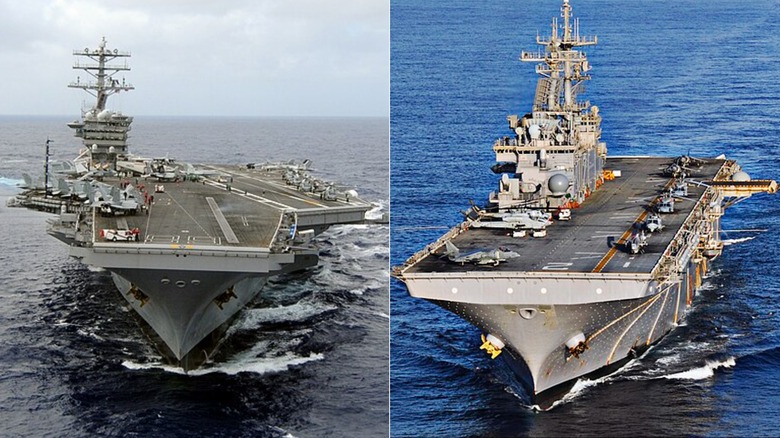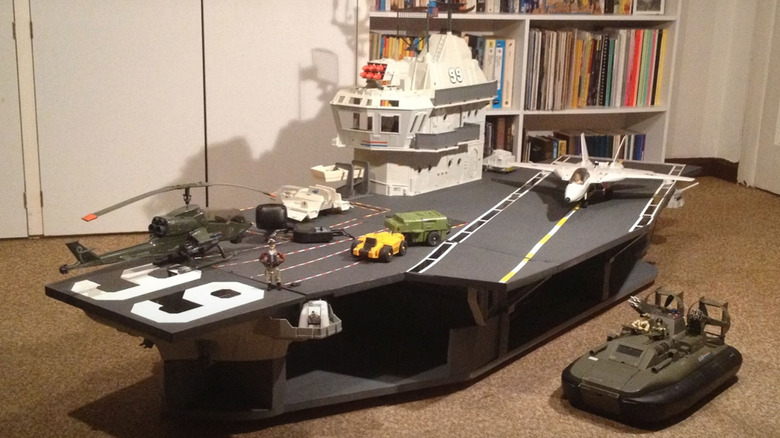Why The Real-Life Inspiration For GI Joe's Iconic Aircraft Carrier Is Still A Mystery
The G.I. Joe toy line from the 1980s remains one of the most popular of its era. It features loads of hero and villain characters, playsets, and vehicles to make battles between the Joes and COBRA as action-packed as possible from the comfort of your living room. The undeniable pièce de résistance is the U.S.S. Flagg, which cost $109.99 when it released in 1985 and boasted dimensions of around 7 feet long, roughly 3 feet in width, and nearly 3 feet in height. What's far less concrete about this toy is its actual inspiration, which remains debated almost 40 years after it hit toy store shelves.
Over the years, the basis for the U.S.S. Flagg has been attributed to two different real-world United States Navy aircraft carriers. A popular claim is that it's based on a Nimitz-Class aircraft carrier, using the look of both the toy and the "G.I. Joe: A Real American Hero" animated series as a reference. However, it's not an exact match, which lends credence to an alleged claim from designer Greg Berndtson. It has been reported that he shared that the vessel was actually loosely based on the U.S.S. Intrepid and is a modified Essex-Class aircraft carrier. The operative word there is "loosely" — making it sound as though he didn't intend for it to be an accurate replica of such ships.
With all of this in mind, the best conclusion one can come to is that the U.S.S. Flagg is its own thing. It includes aspects of both vessels but doesn't strictly represent a Nimitz or Essex-Class aircraft carrier, which are similar yet still rather different in multiple ways.
[Featured images by Michael Cole/U.S. Navy through Wikimedia Commons, Joseph Pol Sebastian Gocong through Wikimedia Commons | Cropped and scaled | Public Domain]
The differences between Nimitz-Class and Essex-Class
The differences between the Nimitz and Essex-Class Supercarriers are numerous, though some of them aren't easily conveyed through a children's toy. Nimitz-class carriers were produced between 1968 and 2009. 10 total were created with a length of well over 1,000ft with a displacement of 100,000 tons. Simply put, these ships are absolutely massive, yet managed to float. They can remain at sea for up to 20 years thanks to their two nuclear reactors and haul between 85 to 90 fearsome fighter jets. As far as armaments, the Nimitz is equipped with four NATO RIM-7 Sea Sparrow missile launchers, three to four 20mm Phalanx CIWS missile defense cannons, multiple MK36 decoy launchers, and more.
Meanwhile, the Essex are a bit different. Constructed between 1943 and 1950, 24 were ultimately completed at lengths between 872 and 888ft. In an unmodified state, their displacement could reach approximately 36,960 tons on their eight Babcock & Wilcox boilers. Despite being significantly smaller than the Nimitz, Essex were capable of carrying around 100 aircraft. Their arsenals included between 32 and 72 Bofors 40mm AA guns, 38-caliber guns, and between 55 and 76 Oerlikon 20mm AA guns.
The Flagg compared to Nimitz and Essex ships
Considering the differences between the Nimitz and Essex-Class Supercarriers, where can one find both of their influence on the U.S.S. Flagg? In terms of the overall shape and scale, the U.S.S. Flagg largely appears to be a compromise between the two ship classes. The deck is long and slender, like an Essex, with a runway off the side synonymous with the Nimitz. If the Flagg were converted from true 1/18 scale, it would come out to roughly 60 to 62 feet long, making it over 1,000 feet if translated to 1/1 scale and, thus, approximately the length of a Nimitz. The tower, or bridge, is also enlarged, resembling that of an Essex rather than a Nimitz.
There's also the matter of the Flagg's deck sticker, 99, which Berndtson supposedly claimed was chosen because of the unlikelihood that the U.S. Navy would reach that high of a CVAN vessel count. It's also visually similar to the U.S.S. Intrepid's 11 deck number, however there's debate regarding whether its supposed to be 66 instead of a 99. The number should be read with the rear of the ship at the bottom, hence the idea that it should be 66. It's also worth noting that the Flagg features 5-inch 38-caliber guns, just like an Essex.
The Nimitz and Essex-Class Supercarriers are both essential to the rise and overall history of the aircraft carrier and will forever be linked to the U.S.S. Flagg. Perhaps, someday, G.I. Joe collectors will learn the definitive truth about its origin, finally putting the debate over which carrier inspired it to bed.


